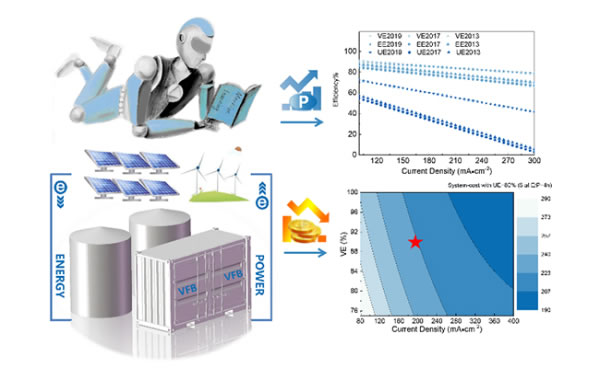
Recently, a team led by researcher Li Xianfeng and researcher Zhang Huamin of the Energy Storage Technology Research Department of Dalian Institute of Chemical Physics, Chinese Academy of Sciences has made progress in optimizing the performance of all-vanadium flow batteries (VFB) and predicting their costs. The prediction and optimization strategy of VFB stack performance and system cost based on machine learning. This method provides guidance for the research and development of VFB, which is expected to improve research and development efficiency, shorten the research and development cycle, and accelerate the industrialization process of VFB.
VFB has the advantages of high safety, long cycle life and high efficiency, and has broad application prospects in the field of large-scale energy storage. At present, VFB is in the stage of commercialization demonstration. How to further reduce costs and improve efficiency is of great significance to its large-scale industrialization. The cost of VFB system consists of power cost (stack), energy cost (electrolyte) and control system. Among them, the cost of power and energy is closely related to the performance of the stack; and the performance of the stack is affected by many factors such as key materials, stack structure, and operating conditions. If only experimental methods are used to optimize the structure and performance of the stack, it takes a long time. Therefore, how to optimize the structure and performance of the stack in an efficient and targeted manner is very important.
Based on the research team's more than ten years of accumulation in the VFB stack research and development process and a large amount of stack data, this work proposes a machine learning-based VFB stack performance and system cost prediction method and optimization strategy. This method takes operating current density as the main characteristic parameter, and the material and structure of the stack as auxiliary characteristic parameters. It can affect the voltage efficiency (VE), energy efficiency (EE), electrolyte utilization rate (UE) and VFB of the VFB stack. The power cost and energy cost of the system are accurately predicted, and the average absolute deviations of the prediction results (training set/test set) are 0.54%/0.47%, 0.62%/0.56%, 3.40%/3.14%, 5.14%/4.97, respectively %, 3.22%/3.08%. In addition, based on the model coefficients, the researchers analyzed and proposed the future development direction of VFB stacks, that is, to develop high power density stacks under the conditions of ensuring higher VE and UE; based on the model established by machine learning and the current material cost, Forecast the trend of VFB system operating cost with VE and UE. This research work not only has guiding significance for the development of VFB stacks, but also provides new ideas for optimizing and predicting the behavior of complex systems by combining machine learning and experimental science.
The above work was recently published in "Energy & Environmental Science" (Energy & Environmental Science). The above work was funded by the National Natural Science Foundation of China, the Chinese Academy of Sciences’ Strategic Leading Science and Technology Special “Key Technologies and Demonstration of Transformational Clean Energyâ€, and the Chinese Academy of Sciences’ Electrochemical Energy Storage Technology Engineering Laboratory.
6 Inch Floor Trap,6 Inches Floor Drain,6 Inches Square Shower Floor Drain,6 Inch Stainless Steel Shower Drain
Kaiping City Jinqiang Hardware Products Co.,Ltd , https://www.jmpowerdrain.com